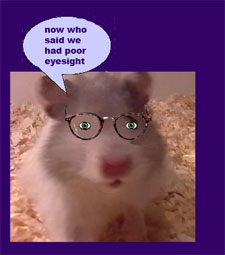| |
Hamster Diabetes
What is diabetes? Diabetes is a condition where a gland in the body called "The Pancreas" fails to produce enough insulin to meet the body's needs. This gland, the pancreas, produces digestive enzymes and manufactures insulin. When starchy food is digested it breaks down into glucose, the glucose then builds up in the blood stream. The insulin controls the level of glucose in the blood by helping it to go from the bloodstream into the body's cells. Once in the cells glucose can be used for energy, or stored for future needs. Without insulin glucose cannot get from the bloodstream into the body cells. Since the cells are deprived of glucose the body then thinks it is being starved so the animal may then eat large quantities of food to try and feed those starving cells.
Glucose levels in the bloodstream will get higher without insulin to allow the glucose to pass from the bloodstream into the cells as it has nowhere else to go. The body then begins to use more muscle and fat to feed those cells, hence the animal develops a ravenous appetite usually accompanied by weight loss.
One job of the kidneys is to prevent the loss of glucose in the urine, all that extra sugar glucose in the bloodstream has got to go somewhere so the kidneys become overwhelmed and the excess sugar then filters into the urine. For this excess sugar to be excreted in the right consistency it needs to be in a liquid form, therefore greater than normal quantities of water are drawn from the body into the bladder creating large volumes of urine to enable the sugar to be flushed away. Because the body fluids are being depleted swiftly the animal develops an un-quenchable thirst and drinks excessively to try and replace those lost body fluids. So when the pancreas fails to work as it should results in the condition known as Diabetes.
 |
Symptoms of diabetes in the hamster are very similar to those in humans. A hamster suspected of having diabetes can show a range of signs. The most common signs are, the hamster may experience shaking or shivering this is sometimes referred to as trembling, excessive drinking of water combined with more than is considered a normal amount of urinating, stumbling, (unsteady gait) a rapid heartbeat heavy breathing, tiredness, lethargy, irritability, behaviour changes, poor co-ordination and eventually possible coma.
Blood sugar levels have to be kept in balance for the body to function efficiently. If blood sugar levels are allowed to drop too low hypoglycaemia (or hypo) is the term used. An immediate and fast effective treatment for a 'hypo' or mild hypo involves consumption of a sugary drink (honey mixed with warm milk) as fluids work quicker than solids, this should be followed by something more substantial in the form of solid food: solid foods take longer to break down and therefore releases at a slower rate.
If a mild hypo is left untreated blood sugar levels will continue to fall starving the rest of the body of glucose and energy leading to more serious problems. In most cases familiarity with the early warning signs and symptoms of hypoglycaemia can be recognized and treated.
A high blood sugar / glucose level, hyperglycemias (or hyper) is the term used. This may cause the hamster to become fatigued and dehydrated, the hamster may experience an un-quenchable thirst and drink excessively, therefore pass a lot more urine than is considered normal.
 |
In some pets diabetes may not be caused not by a lack of insulin itself, but can be the result of hormonal changes.
Diabetes is very rarely seen in the Syrian hamster but is not unknown. The Dwarf hamster is predisposed to this disease.
The longer this is left untreated the more complications are likely to set in. Diabetes can cause serious health issues this includes heart disease, blindness, cataracts and kidney failure. Diabetes is a metabolic disease that requires treatment and lifestyle changes.
There is no cure for Type 2 diabetes but diet is a critical component of treatment, and in many cases this can be quite effective on its own. (Diabetic diet)
An early diagnosis and treatment may prevent or reduce further complications.
Typically, the very early signs of the onset of diabetes are increased thirst and frequent urination (known as Polyuria.) Changes in appetite can increase and decrease.
The Campbell's dwarf hamsters are predisposed to this condition: The cause of diabetes mellitus is complex and involves both genetic and environmental factors. The chances of a hamster developing type 2 diabetes can increase with age. Obese and overweight hamsters are also at risk as overweight animals may not produce the quantity of insulin needed.
A hamster with a bladder or a kidney infection may drink and urinate excessively producing very similar symptoms to diabetes. Some owners may misdiagnose this condition which can be treated effectively and a veterinary visit will be needed to confirm the cause.
Diabetes Mellitus
|
|


